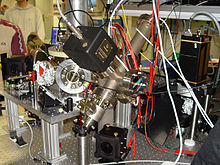Ion trap
Ions , i.e. electrically charged atoms or molecules , are held in an ion trap by means of electric and magnetic fields . Depending on the type and strength of the applied fields, ions of a certain mass can be specifically “trapped”. Alternatively, all ions can be kept in the trap and, by changing the fields, ions of a certain mass can be removed and the ion store can be scanned in a targeted, mass-separated manner.
development
In 1953, the physicist Wolfgang Paul developed the theory of storing ions in an electrical, oscillating quadrupole field. The concept of the Paul trap was of secondary interest to analysts, since only ions of a certain m / z ratio could be stored. In 1983 the method was expanded by George Stafford , which led to the breakthrough of this technology in analytical chemistry, since it was now possible to store all masses and selectively remove them.
methodology
The ions are stored in a vacuum and without contact with a surface. There are different versions of the ion trap; the most commonly used are the Paul Trap and the Penning Trap .
In the Paul trap, a time-varying electromagnetic field is used to trap ions. If this field has the shape of a quadrupole , the trap is also known as a quadrupole trap. The Paul trap is closely related to the quadrupole mass spectrometer.
In the Penning trap, a combination of an electrical field that is constant over time and a magnetic field that is also constant over time leads to the ions being stored. Several other types exist. In an electron beam ion trap , for example, a highly focused electron beam is used in combination with static electric fields. The electrostatic ion beam trap ( Electrostatic Ion Beam Trap ) uses electrostatic fields exclusively, to store a beam of ions at a comparatively high kinetic energy.
Ion traps have applications in mass spectrometry , in optical precision spectroscopy and in the construction of quantum computers.
Example of the application of a Paul trap in analytics
With this "ion trap" an alternating voltage in the radio frequency range is applied to the end cap and ring electrode. If the voltage is correct, the trajectories of the masses become unstable and only the ions with an exactly matching m / z ratio remain in the trap; this is used for ion selection.
With ion trap mass spectrometers, multiple collision experiments can be carried out one after the other (MS n ). Fragments obtained can be selected and further fragmented in a targeted manner. The signal-to-noise ratio is better and the devices are accordingly sensitive.
Web links
Individual evidence
- ↑ George Stafford: Ion trap mass spectrometry: A personal perspective . In: Journal of the American Society for Mass Spectrometry . tape 13 , no. 6 , June 2002, ISSN 1044-0305 , p. 589-596 , doi : 10.1016 / S1044-0305 (02) 00385-9 ( springer.com [accessed January 25, 2020]).
- ↑ a b Ng, CY (Cheuk-Yiu), 1947-, Baer, M. (Michael): State-selected and state-to-state ion-molecule reaction dynamics . J. Wiley, New York 1992, ISBN 0-471-53258-4 .
- ↑ Kielpinski, David .: Architecture for a large-scale ion-trap quantum computer . http://dx.doi.org/10.1038/nature00784 , 2002.
